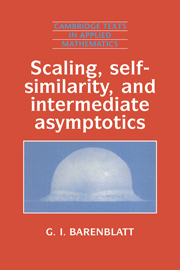 Scaling, Self-similarity, and Intermediate Asymptotics
Scaling, Self-similarity, and Intermediate Asymptotics Book contents
- Frontmatter
- Dedication
- Contents
- Preface
- Foreword
- Introduction
- 1 Dimensions, dimensional analysis and similarity
- 2 The construction of intermediate-asymptotic solutions using dimensional analysis. Self-similar solutions
- 3 Self-similarities of the second kind: first examples
- 4 Self-similarities of the second kind: further examples
- 5 Classification of similarity rules and self-similar solutions. A recipe for the application of similarity analysis
- 6 Scaling and transformation groups. Renormalization group
- 7 Self-similar solutions and travelling waves
- 8 Invariant solutions: asymptotic conservation laws, spectrum of eigenvalues, and stability
- 9 Scaling in the deformation and fracture of solids
- 10 Scaling in turbulence
- 11 Scaling in geophysical fluid dynamics
- 12 Scaling: miscellaneous special problems
- Afterword
- References
- Index
10 - Scaling in turbulence
Published online by Cambridge University Press: 18 December 2014
- Frontmatter
- Dedication
- Contents
- Preface
- Foreword
- Introduction
- 1 Dimensions, dimensional analysis and similarity
- 2 The construction of intermediate-asymptotic solutions using dimensional analysis. Self-similar solutions
- 3 Self-similarities of the second kind: first examples
- 4 Self-similarities of the second kind: further examples
- 5 Classification of similarity rules and self-similar solutions. A recipe for the application of similarity analysis
- 6 Scaling and transformation groups. Renormalization group
- 7 Self-similar solutions and travelling waves
- 8 Invariant solutions: asymptotic conservation laws, spectrum of eigenvalues, and stability
- 9 Scaling in the deformation and fracture of solids
- 10 Scaling in turbulence
- 11 Scaling in geophysical fluid dynamics
- 12 Scaling: miscellaneous special problems
- Afterword
- References
- Index
Summary
Homogeneous and isotropic turbulence
10.1.1 The problem of turbulence
This chapter differs from the previous ones in that scaling laws and self-similar solutions of the first and second kind will be established by making essential use of experimental data and without turning to a mathematical formulation of the problem, which, for turbulence, is lacking at the present time.
The problem of turbulence, to which this chapter is devoted, is considered with good reason to be the number-one problem of contemporary classical physics. Discovered by Leonardo and baptized by Lord Kelvin, it has attracted the greatest minds of the century, including such giants as W. Heisenberg, A.N. Kolmogorov, G.I. Taylor, L. Prandtl, and Th. von Kármán. Nevertheless, it remains an open problem: none of the results available has been obtained from first principles. They are based essentially on strong additional assumptions, which may or may not be correct.
The phenomenon of turbulence, as is well known, consists in the following. As we have seen in chapter 1, the basic similarity parameter that governs the global properties of the flow of an incompressible viscous fluid is the Reynolds number ρUl/μ (ρ being the density and μ the viscosity of the fluid, U a characteristic speed, and l a characteristic length scale of the flow). When the Reynolds number reaches a certain critical value Recr, different for different flows (for example, for flow in a smooth cylindrical pipe of circular cross section, Recr ∼ 103, for flow in a boundary layer, Recr ∼ 105), the character of the flow changes suddenly and sharply. A stream that at subcritical values of the Reynolds number was regular and ordered – laminar – becomes essentially irregular both in time and in space. The flow properties for supercritical values of the Reynolds number undergo sharp and disorderly variations in space and time, and the fields of flow properties, – pressure, velocity, etc. – can to a good approximation be considered random. Such a regime of flow is called turbulent.
- Type
- Chapter
- Information
- Scaling, Self-similarity, and Intermediate AsymptoticsDimensional Analysis and Intermediate Asymptotics, pp. 252 - 295Publisher: Cambridge University PressPrint publication year: 1996
